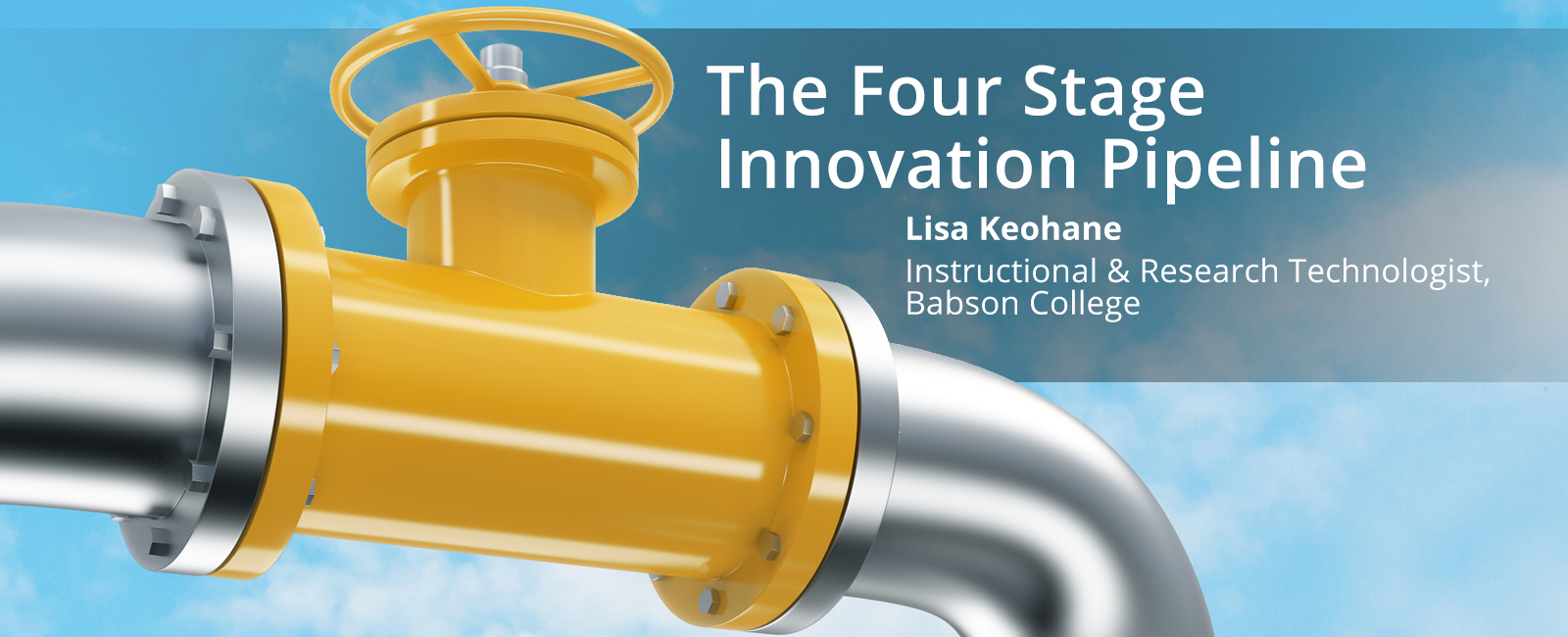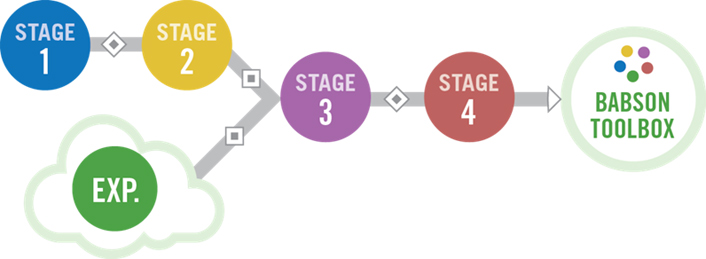Key Takeaways
- Babson College has initiated a process called the Innovation Pipeline that helps address the challenge of evaluating technology and ensures faculty involvement along the way.
- The Innovation Pipeline is both a process and a fully developed web-based portal that clarifies how technology decisions are made that impact the curriculum at Babson.
- At the end of the pipeline process, communicating the results of the evaluation and all the information surrounding the new campus tool requires a clear marketing and communication plan.
Babson College has initiated a process called the Innovation Pipeline that helps address the challenge of evaluating technology and ensures faculty involvement along the way. Evaluating technologies that impact the curriculum can be a challenge, from what tool to use to how to assess pilots and how to communicate technology decisions to faculty. This article outlines the process and explains the platform Babson uses to communicate the adoption of innovative and academic technologies.
Background
Watch the video interview on which this article is based.

Babson College is a private college in Wellesley, Massachusetts, with an undergraduate and graduate population of approximately 3,600 students. The Innovation Pipeline was developed because of communication needs, specifically the need to communicate with the Babson community about new and emerging technologies.
An example that illustrated the need for a process was when we made the switch from Turnitin to an alternate solution. This resulted in a big surprise for many on campus. That's when we said, "We have a communication issue and there is a need to include the community as part of the decision-making process." We developed the idea of providing a place that will have information about the technologies used at Babson. We needed a way to evaluate technologies for classroom use, including those emerging technologies discovered in our research process. To operate effectively, we know we need to keep faculty informed and engaged and also hear feedback on what's working and what's not.
Enter the Innovation Pipeline
Often faculty members come to our group (Academic Technology Innovation Center) to discuss a technology they are using or have heard about. Other technologies catch our attention during research or when working with our instructional designers. If we think a technology will enhance the learning experience or fix a problem, we move it through the Innovation Pipeline.
The Innovation Pipeline is a four-step, stage-gate process. The first stage is the concept stage. The concept stage is looking at the technology and determining if there is a need, if it will solve a problem, and also if it will enhance the learning experience. Once this is determined we move to stage two.
Stage two is the internal testing stage and, for me, one of the most exciting parts of my job. This stage involves research, benchmarking, reading reviews, and learning how the technology works. We also look at potential costs, budget, and resources. We often extend an invitation to our stakeholders (faculty, staff, students) during this stage to work together to determine if we should pilot the technology.
Stage three is the pilot stage. A pilot team is assembled that includes faculty, an instructional designer, myself as the project leader, and also members of our support center to help with technology support. Part of the pilot process also includes training and documentation.
At the end of the pilot we determine if it was successful by using a checklist of items we consider relevant, such as user-friendliness, the technology's capabilities, student use, classroom enhancement, and so forth. Before we can move forward, an important part of this stage is presenting the pilot findings to our Gate 3, or G3 team. The G3 team consists of our CIO, the Academic Technologies director, and faculty members representing departments across campus. We report on the pilot and get either a go-ahead to roll out the new technology or a "stop" of some kind. One of the main benefits of the Innovation Pipeline is that not all projects are approved. We've hit a technology stop many times, with feedback such as "we don't have the support for it, we don't have the budget for it, or it is not easy to use." That's the benefit of stage three and the G3 team — we don't put a rubber stamp on every piloted technology. It is a great vetting process that allows faculty to speak about the use of the new technologies. It also ensures full transparency throughout the process, so there are no surprises.
Stage four is the rollout. This stage is a big process because we need to establish and obtain a budget and train faculty, staff, and students on the technology. We do a lot of training, including our support staff on handling support calls. If we work with a vendor, we set up all of the support on that end as well.

Example of Group Peer Review
One of my favorite projects in the Innovation Pipeline was creating a Group Peer Review tool. An Innovation Pipeline project begins with a need. We have faculty that use student groups in their courses and were looking for the ability to have their students evaluate each other. For a long time, we used Qualtrics, but creating groups every semester required a lot of time on the admin side for faculty. We wanted to find a technology that would work more easily for them.
We worked with the development team at Babson to develop a tool in-house that met the needs for this project. The resulting tool integrated groups created from Blackboard using questions that faculty helped develop. We piloted the new tool, and both students and faculty were happy with it. The rollout involved presentations to the Babson community to spread the word that we have this great in-house tool that went through the Innovation Pipeline and it works well.
Campus Reaction to the Innovation Pipeline
We receive good feedback from members of our community who have worked on projects moved through the Innovation Pipeline. With technology changing so fast, moving projects through the Innovation Pipeline helps keep the Babson community informed and involved in the latest innovations. The next big step for us is to market the process better so that the benefits can be shared across campus.
Lessons and Recommendations
As an instructional technologist, I'm always looking for new technologies to put through the Innovation Pipeline process. I think the importance of engaging faculty is the key thing we learned throughout development of the Innovation Pipeline. We all have tech-savvy faculty on our campuses who love technology. A multi-stage process like the Innovation Pipeline ensures transparency and makes everyone part of the process.
After working with faculty interested in being early adopters, the next steps are to develop a plan to communicate the technology and the decision process, and to work effectively with the faculty throughout. I recommend having a good marketing communication plan early in the process. It is important to communicate the tools available and include the community in the vetting process for tools that might be beneficial.
Up Next for the Innovation Pipeline
Currently, our plans involve creating a marketing plan and upgrading our website portal for the Innovation Pipeline. We are in the process of building an interactive updated site that will allow members of the Babson community to submit new technology ideas. It will also provide an opportunity to indicate interest in a technology listed in any one of our four stages. We are meeting with faculty for feedback before we launch to the community.
Lisa Keohane is an instructional and research technologist at Babson College.
© 2016 Lisa Keohane. The text of this article is licensed under Creative Commons BY-NC-ND 4.0.
